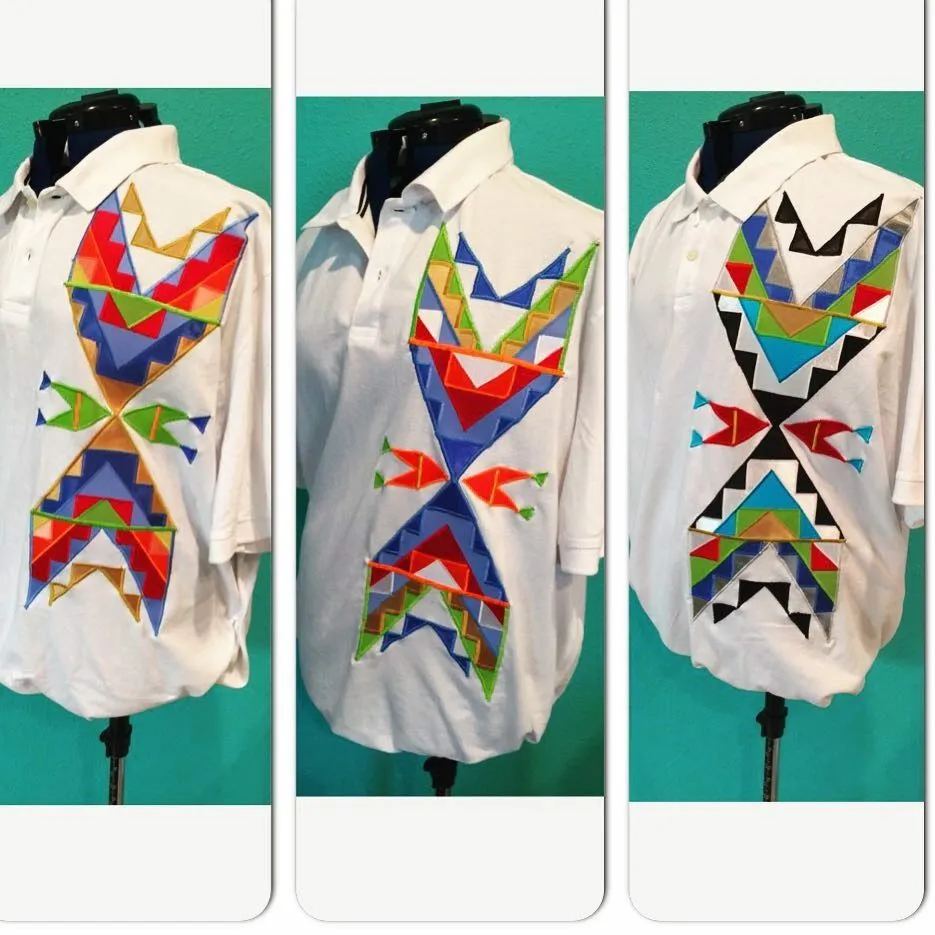Blog
Native American Mens Ribbon Shirts
In the rich cultural mosaic of Native American communities, every garment tells a story, and the men’s ribbon shirt is no exception. These iconic shirts are far more than just clothing; they are living embodiments of heritage and identity.
With vibrant colors and intricate designs, Native American men’s ribbon shirts have become a symbol of cultural pride and artistic expression, weaving together the threads of tradition and style. Join nativeamericanclothes.com explore the history, significance, and craftsmanship behind these remarkable garments that continue to captivate hearts and minds.
What is the meaning of a Native American ribbon shirt?
Ribbon shirts, a cherished symbol of Native pride, have a rich history that spans from cultural gatherings to contemporary boardrooms. These garments serve as more than just clothing; they encapsulate personal expression, tribal traditions, and a deep sense of heritage.
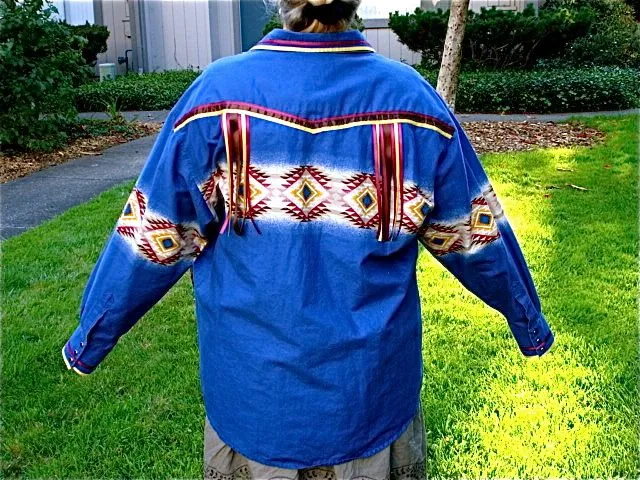
Crafted from materials like cotton or linen, ribbon shirts often feature colorful ribbons intricately appliqued or sewn into seams, sometimes in the form of tassels. Their origins are a testament to Native fashion’s ability to blend tradition, innovation, and diverse inspirations. In this exploration, we’ll dive into the captivating history and evolution of ribbon shirts.
From Origins to Innovations: The Journey of Ribbon Shirts
Roots of Tradition
The history of ribbon shirts is deeply rooted in Indigenous culture, and their significance extends far beyond mere fashion. These shirts find their origins in the cultural gatherings of Native American communities, particularly those of the Plains tribes. The ribbon shirt served as traditional attire during powwows, ceremonies, and celebrations, representing not only style but a profound connection to heritage.
Melding of Materials
While ribbon shirts may appear simple at first glance, the materials and craftsmanship behind them are anything but. They are typically fashioned from cotton or linen, offering both comfort and durability. These fabrics provide a canvas for the vibrant ribbons that adorn them, allowing for a unique blend of color and texture.
What makes ribbon shirts truly remarkable is the creativity and skill in the way the ribbons are incorporated, sometimes in complex patterns, into the fabric, seamlessly merging form and function.
Ribbon Magic: The Art of Expression
One of the most enchanting aspects of ribbon shirts is the sheer diversity of design. They can range from understated and subtle to intricate and flamboyant, a testament to the wearer’s personal expression. Each shirt tells a unique story, often reflecting tribal affiliations, personal experiences, or spiritual beliefs. This allows for an incredibly personalized and meaningful piece of attire that transcends mere aesthetics.
Influences and Inspirations
Native fashion is a dynamic fusion of influences, and ribbon shirts are no exception. They draw inspiration from a multitude of sources, combining traditional designs with contemporary interpretations. The vibrant colors and patterns of the ribbons often incorporate elements of tribal symbolism. These inspirations come from the natural world, spiritual beliefs, and historical events, providing a layer of depth and significance to the garment.
A Symbol of Cultural Resilience
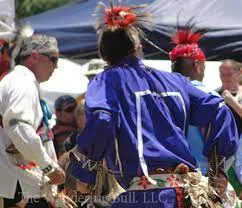
Ribbon shirts are more than just clothing; they are a symbol of cultural resilience. They have adapted over time, from their origins in tribal gatherings to becoming a prominent piece of attire in various settings, including professional ones. In boardrooms and corporate spaces, ribbon shirts are donned with pride, bridging the gap between cultural heritage and contemporary life.
The Ever-Evolving Fashion Statement
As with all fashion trends, ribbon shirts have evolved with the times. Contemporary ribbon shirts are a blend of tradition and innovation, appealing to both Native communities and the broader fashion world. They have become a statement of cultural identity and pride, capturing the essence of Native heritage while making a lasting impact on the fashion landscape.
A Garment of Heritage and Expression
The history and evolution of ribbon shirts are a testament to the enduring spirit of Native culture. From their humble beginnings at powwows to their role in corporate settings, ribbon shirts continue to be a source of pride and heritage for Indigenous peoples. T
hey are more than mere attire; they are a canvas for personal expression, tribal tradition, and cultural resilience. The vibrant ribbons that adorn these shirts tell stories of diversity, inspiration, and the enduring legacy of Native fashion.
Read more: Native American Bracelets For Men
What is the history of Native American ribbon shirts?
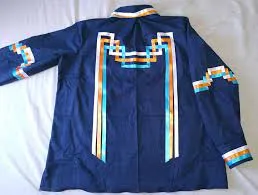
The legacy of ribbonwork is a captivating tale that transcends continents and centuries. This intricate craft, with its origins rooted in the Great Lakes region, took a fascinating journey through history. It was deeply influenced by the arrival of French traders, touched by the winds of revolution, and eventually revitalized by a Native cultural resurgence.
Ribbonwork’s French Connection
French Traders and the Great Lakes
The enchanting world of ribbonwork began to take shape in the late 18th century when French traders introduced silk ribbons to the Great Lakes region. These ribbons, originally used to adorn extravagant European clothing, found themselves on a transatlantic voyage to the Americas.
As Europe bid farewell to opulent ribbon-clad attire, these colorful embellishments embarked on a new chapter in the New World. Alongside silk ribbons, trade in the Great Lakes area included a wide array of goods like metal knives, cookware, bells, small mirrors, glass and brass beads, guns, alcohol, and wool blankets, reflecting the rich tapestry of cultural exchange.
A Mystery Unveiled
Origins of Ribbonwork Appliqué
The exact genesis of ribbonwork appliqué remains shrouded in history’s mists, but by the dawn of the 19th century, European observers noted this unique style of decoration among several Indigenous tribes. The first documented instance of ribbonwork appliqué emerged on a Menominee wedding dress in 1802, offering a tantalizing glimpse into the craft’s early days.
The art of ribbonwork began to flourish in the last quarter of the 19th century, radiating outward from its Great Lakes heartland to encompass tribes in the Prairies, Plains, and Northeast regions.
A Century’s Grace
Ribbonwork’s Flourishing and Fading
The golden age of ribbonwork appliqué spanned a mere century, and by the early 1900s, this remarkable craft began to wane. This period coincided with the dislocation of numerous tribes from their ancestral lands and traditional ways of life. As a result, the appliqué technique fell into obscurity within many tribal communities or was kept alive by only a handful of dedicated individuals.
A Rebirth in Native Art
Ribbonwork Resurgence and Indian Activism
The 1930s brought a rekindled interest in Native art, and federal agents embarked on collecting information about the traditional production of ribbonwork among its original practitioners. Museums, recognizing its cultural significance, also began to display early examples of ribbonwork.
The 1970s marked a significant turning point, as a Native cultural resurgence and Indian activism breathed new life into ribbonwork. Various Prairie and Plains tribes resurrected the art form, paying homage to their heritage.
Reviving Tradition
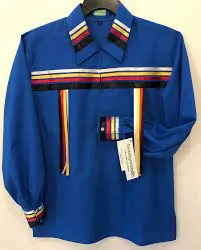
Modern Ribbonwork: Adaptation and Economic Value
Contemporary ribbonwork has not remained untouched by the passage of time. The introduction of modern conveniences, such as sewing machines, has made the craft more accessible and allowed for innovation. Ribbonwork, like other Native art forms, holds economic value in non-Indian markets.
Despite the modifications from its traditional form, ribbonwork remains primarily a cherished tradition among American Indians, adorning items worn during Native cultural events, especially powwows.
A Resilient Artistry
The journey of ribbonwork is a testament to its enduring spirit. From its serendipitous introduction by French traders to its revival through Native cultural resurgence, ribbonwork has traversed an incredible historical path.
It symbolizes the adaptability and resilience of Indigenous culture, paying homage to tradition while embracing contemporary innovation. The vibrancy of ribbonwork reflects the enduring legacy of Native art, celebrating a craft that continues to thrive and captivate hearts both within and beyond Native communities.
Can non-Indigenous wear ribbon skirts?
Ribbon skirts, a cherished tradition in Indigenous communities, have woven a rich tapestry of history, culture, and empowerment. The journey of these vibrant garments embodies the resilience and strength of Indigenous people. In this exploration, we delve into the legacy and contemporary significance of ribbon skirts, shedding light on the cultural connection they foster.
Legacy of Ribbon Skirts
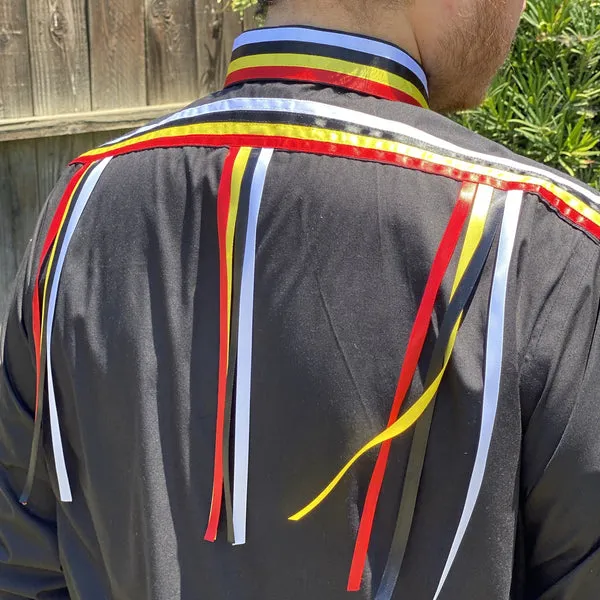
Leah Dorion’s Dedication
Leah Dorion, a Métis artist residing near Prince Albert, Saskatchewan, has been a dedicated advocate for the preservation of Métis-style ribbon skirts. Through her teachings and artistic contributions, she has inspired many Métis women and allies. Leah’s commitment to the heritage of ribbon skirts has been instrumental in passing on the knowledge of their history and the art of crafting them.
Inclusivity and Protocol
In addressing the question of non-Indigenous individuals embracing the tradition of ribbon skirts, Leah Dorion offers valuable insights. She believes that as long as protocol and respect for the skirts’ significance are observed, there is no inherent impropriety in non-Indigenous people wearing them.
Leah acknowledges the existence of authentic and passionate individuals who engage with Indigenous communities in meaningful ways. These individuals, driven by respect and a sense of service, often participate in Indigenous ceremonies and have been recognized and accepted by these communities.
A Cultural Connection
Leah Dorion and her colleague Bonny Johnson have authored a book titled “sînapân kîskasâkâs: A Guide to Making Contemporary-Style Métis Ribbon Skirts.” This publication serves as a valuable resource for understanding the history and art of Métis ribbon skirts. It encapsulates the cultural significance of these garments and provides guidance on crafting contemporary versions.
Ribbon Skirts as a Spiritual Symbol
Ribbon skirts are not mere garments; they hold a profound spiritual significance. For many, wearing a ribbon skirt is a way to honor oneself and one another. Donning these sacred skirts is an intentional act that grounds the individual, fosters a sense of belonging, and enables them to serve their community with love and openness. Ribbon skirts are more than fabric; they are vessels of spiritual connection.
A Path to Cultural Reconnection
The act of wearing a ribbon skirt is not obligatory; rather, it is a personal choice. Ribbon skirts, however, offer a path to cultural reconnection and a profound sense of kinship. Indigenous people, like others around the world, have faced historical challenges that often led to cultural disconnection. These vibrant garments symbolize a return to one’s heritage, a revival of traditions, and a celebration of resilience.
Rediscovering Pride
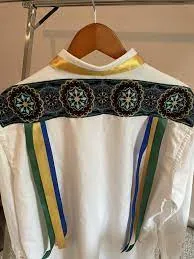
Ribbon skirts hold the power to reconnect individuals with their family, relatives, ceremonies, land, and language. Through these garments, people are reminded of their strength, resilience, and the significance of their cultural identity. In a world where history has often marginalized Indigenous cultures, ribbon skirts stand as a symbol of pride and resilience. They remind individuals that they have overcome adversity and continue to embrace their rich heritage.
Ribbon skirts are not just articles of clothing; they are threads that connect the past, present, and future of Indigenous communities. They embody strength, resilience, and unity. As Leah Dorion rightly emphasizes, it is the respect for protocol and the commitment to engaging with Indigenous communities that define the appropriateness of wearing these skirts.
Ribbon skirts continue to play a crucial role in fostering cultural connections, empowering individuals, and celebrating Indigenous heritage.
What is the history of the Cherokee ribbon shirt?
In the heart of Cherokee Nation, a dedicated artisan, Frances Donelson, has become a beacon of tradition. With her skilled hands and unwavering commitment, she ensures the legacy of tear dresses and ribbon shirts remains vivid in the fabric of Cherokee culture. Let’s embark on a journey to explore the profound significance and the remarkable artistry behind these traditional garments.
Tear Dresses: A Link to History
Cherished Traditional Attire
The tear dress, an iconic symbol of Cherokee heritage, has deep roots in the Trail of Tears era. During this trying period in history, women had limited access to essential tools, including scissors, due to the challenges of forced removal and confiscation of belongings. As a result, the tear dress was born from necessity. It was crafted by tearing fabric from larger pieces, ultimately forming a distinctive style characterized by its diamond patterns along the skirt and sleeves.
Evolving Silhouettes
Over time, the tear dress has evolved. The Trail of Tears-era dress featured quarter-length sleeves and a mid-calf skirt length. The button-down tops and back-fastened buttons, especially for infants, were common attributes. In contemporary renditions, these dresses have transformed into floor-length attire with full-length sleeves, allowing for a more modern interpretation while preserving tradition.
Artistry of Frances Donelson
Preserving Tradition through Sewing
Frances Donelson, a Cherokee Nation citizen, embarked on her journey of preserving tradition through sewing in 1993. What started as a small endeavor quickly transformed into a profound mission. Donelson’s journey was inspired by her sister’s participation as a Cherokee National Holiday vendor. Her sister’s suggestion to create a few tear dresses kindled the spark of tradition within her.
The Dedication to Craftsmanship
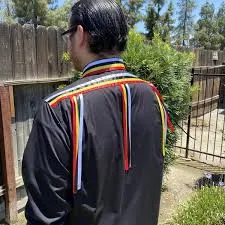
Donelson’s journey into crafting tear dresses has been marked by dedication and passion. Through observation and learning from existing examples, she honed her skills. Her first creation consisted of just five dresses, which were quickly snapped up. The popularity of her creations prompted her to create more, adapting to the custom requirements of her clients.
Innovating with Elastic Bands
One key innovation introduced by Donelson was the addition of elastic bands to the waist and wristbands. This modification allowed for greater flexibility in sizing, catering to a wider range of clients. Recognizing that each garment she created was unique and made for different individuals, Donelson aimed to ensure that the tear dresses could fit a variety of wearers comfortably.
Preserving Multiple Traditions
Crossing Boundaries with Craftsmanship
Frances Donelson’s artistry isn’t limited to preserving Cherokee traditions alone. She also skillfully crafts Muscogee Creek and Choctaw tear dresses and ribbon shirts. The complexity of creating these dresses varies, with Choctaw dresses often requiring substantial handwork. Donelson invests approximately 80 hours to complete a single Choctaw dress.
Global Reach
Donelson’s artistry knows no boundaries. Her creations have found homes in California, Texas, Hawaii, Washington, New Jersey, and even Germany. While many artisans choose to establish an online presence or use social media for promotion, Donelson relies solely on word-of-mouth recommendations. Her dedication and craftsmanship have spoken for themselves, creating a thriving network of satisfied customers and patrons.
A Labor of Love
Sustaining Tradition through Affordable Craftsmanship
Donelson’s commitment to tradition is evident not only in her craft but also in her pricing. She charges $60 for an adult ribbon shirt, $45 if the client provides the material. The Cherokee tear dresses she crafts come in various sizes, with costs ranging from $75 to $150, depending on the size and whether the client provides the material. While the pricing reflects the cost of materials and her time, Donelson emphasizes that her craft isn’t a primary source of income.
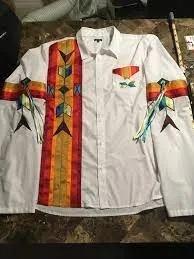
A Rewarding Passion
For Frances Donelson, crafting these traditional garments isn’t just a hobby; it’s a passion and a profound connection to heritage. She finds joy in creating these dresses, keeping herself busy with a meaningful pursuit. Her dedication and the appreciation of her clients motivate her to continue crafting these beautiful pieces.
Frances Donelson’s craftsmanship transcends mere sewing; it’s a dedication to preserving the rich tapestry of Cherokee tradition. Through the timeless artistry of tear dresses and ribbon shirts, she ensures that the cultural heritage of Cherokee Nation remains vibrant and continues to thrive.
Native American Mens Ribbon Shirts
When we think of Native American attire, it’s easy to conjure images of vibrant regalia, intricate beadwork, and feathered headdresses. Among these iconic symbols of indigenous culture, the Native American men’s ribbon shirt stands out as a piece that exudes tradition, meaning, and elegance. In this exploration, we delve into the cultural significance and the artistry behind these captivating garments.
The Essence of Ribbon Shirts
An Epitome of Native American Elegance
The Native American men’s ribbon shirt is a quintessential piece of indigenous clothing that carries a rich history. These shirts are often characterized by their classic cut, featuring long sleeves and colorful ribbons that are appliqued or sewn into seams as tassels. Though the styles and designs may vary, they consistently reflect the intricate artistry and cultural significance of Native American tribes.
A Stitch in Time: Historical Roots
Preserving Tradition through Fabric
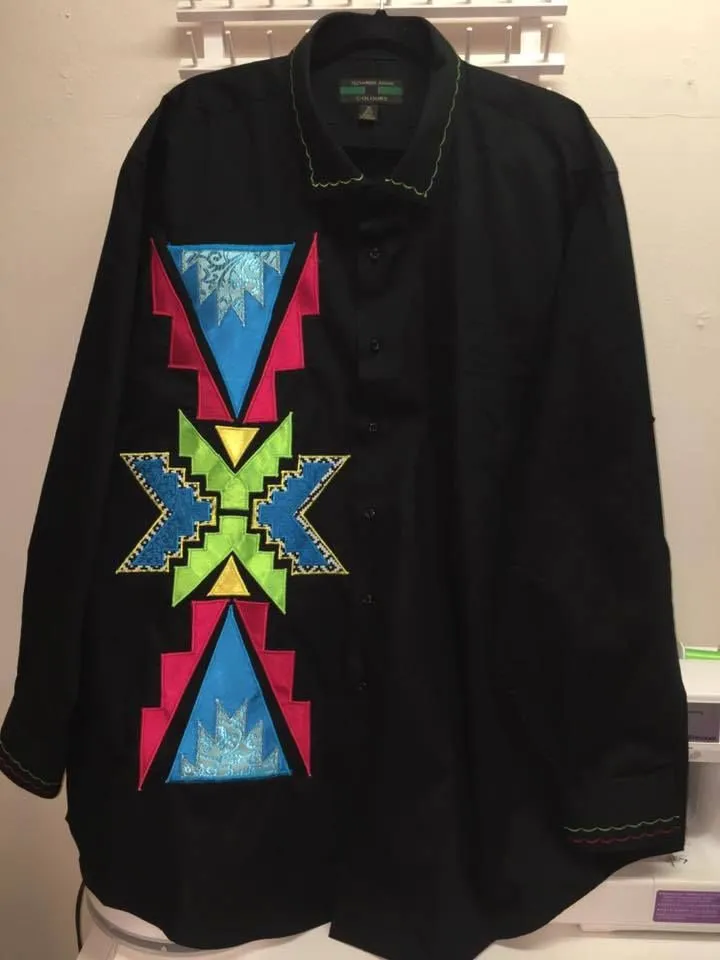
The history of ribbon shirts dates back to the bygone eras of Native American tribes. One might wonder about the origin of this attire. It’s believed that ribbon shirts, and the incorporation of ribbons into indigenous clothing, were influenced by the introduction of silk ribbons by French traders to the Great Lakes region in the late 18th century.
Following the French Revolution, extravagant European clothing adorned with ribbons went out of fashion. Consequently, unwanted ribbons were exported to the Americas. This influx of silk ribbons marked the beginning of a transformative journey in indigenous fashion.
The use of silk ribbons was intertwined with the trade of various items, including metal knives, cookware, bells, mirrors, glass, brass beads, guns, alcohol, and wool blankets in the Great Lakes area. The exact origin of ribbonwork applique remains shrouded in history, but it gained prominence among several tribes by the early 19th century.
As the 19th century progressed, the art of ribbonwork reached its zenith, expanding from the Great Lakes region to tribes in the Prairies, Plains, and Northeast. Its growth was concomitant with the dislocation of many tribes from their traditional homelands and ways of life. Consequently, the art of ribbonwork was preserved in only a few groups or by select individuals.
Resurgence: A Tale of Cultural Renaissance
A Revival of Artistry
The early 1900s marked a period of decline in the practice of ribbonwork due to the dislocation of indigenous communities. However, in the 1930s, government interest in native art sparked a resurgence. Federal agents began collecting information about the traditional production of ribbonwork, and museums began displaying early examples of these exquisite pieces.
By the 1970s, coinciding with the Native American cultural resurgence and activism, ribbonwork once again graced the attire of various Prairie and Plains tribes. Since then, this art form has experienced a revival.
The Artistry of Ribbon Shirts
Techniques, Motifs, and Tribes
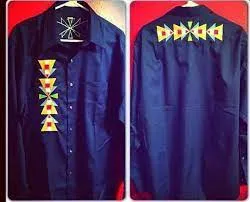
Ribbon shirts are not just pieces of clothing; they are works of art. The creation of these shirts involves a masterful blend of techniques, artistic elements, and tribal motifs. The artistic elements and motifs incorporated into these shirts are a testament to the creative genius of Native American artisans.
Each tribe imparts its unique touch to ribbon shirts, adding distinctive patterns and symbolism. From the vibrant colors to the intricately sewn ribbons, these shirts capture the essence of the tribe’s culture. Some tribes are particularly renowned for their craftsmanship in creating these shirts, such as the Navajo and Zuni, who have left an indelible mark on the art of ribbon shirts.
From Tradition to Trend: Influence on Modern Fashion
Embracing Cultural Elegance
In recent years, Native American men’s ribbon shirts have transcended their cultural origins and have become more widely recognized and appreciated. Their elegance and rich symbolism have influenced modern fashion trends.
These shirts have found their place beyond Native American communities and are now often worn in various settings, including weddings, gatherings, and cultural events. The allure of ribbon shirts lies not only in their beauty but also in the cultural stories they tell. They serve as a bridge between the past and the present, connecting people with the rich heritage of Native American tribes.
Native American men’s ribbon shirts are more than just clothing; they are living symbols of cultural pride, artistic expression, and the enduring spirit of indigenous traditions. Their journey from historical significance to contemporary influence showcases the profound impact of these garments on the world of fashion and culture.

